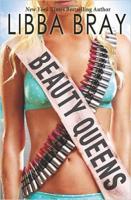
Beauty Queens follows a simple concept: what if a plane full of beauty queens crash-landed on a deserted island, a la Lord of the Flies?
Except it’s not quite so simple as that. This is the story of the survivors, fourteen typical (and atypical) beauty queens who must work together to stay alive and keep their pageant skills sharp until help arrives.
This entails battling massive snakes, building and maintaining a camp, fighting over the remaining beauty supplies, and coming to the realization that the island might not be deserted after all.
First off, this book is laugh-out-loud funny. It not only pokes fun at the world of beauty pageants, but also at capitalism, consumerism, the beauty industry, societal expectations, government and politics, and the ways we (and others) define the idea of being American.
For a book published in 2011, it’s remarkably still relevant, perhaps even more so now than it was at the time of printing.
The best part of this book is the characterization and character development. Of the fourteen girls, the book focuses on nine of them, following them through their struggles, triumphs, and self-discovery on the island.
The book doesn’t shy away from hard topics, either. Multiple characters experience struggles in relation to their sexuality or gender identity, from being singled out for their identity to confronting society’s expectations of how a woman should treat her sexuality. Three of the main characters are LGBTQ+.
The book also addresses racism, both in the pageant circuit and in general, through the relationship between Nicole and Shanti, the only contestants of color. The girls start out with an adversarial relationship (as they both know the judges will only allow one person of color to place), but as the book continues, both are forced to confront their own inner struggles with ethnicity, identity, and what it means to be a woman of color in America.
Despite the humor of the book, author Libba Bray handles each topic with grace and gives it ample time to be addressed and dealt with by the characters. Although each of the nine central girls has her own arc, Bray is able to juggle them all effortlessly and bring each to a satisfying conclusion.
Of course, with the island not being completely deserted (and the later appearance of a band of pirates), there are other memorable characters to be had. The ambitious, metaphor-mixing Ladybird Hope, dissatisfied and overburdened Agent Jones, and the Elvis-loving mini dictator MoMo B. ChaCha all serve to round out the story and provide entertainment along the way.
It’s also impossible to talk about this book without mentioning The Corporation, the megacorporation sponsoring the pageant and basically everything else in America, which is definitely not supposed to represent any real corporation in any way.
The book opens with an introductory “word from our sponsor,” the aforementioned Corporation. Interspersed throughout the book are transcriptions of commercials for various beauty products sold by The Corporation, as well as the Miss Teen Dream pageant fact sheets about the contestants.
Through these, the reader is able to grasp the standards and expectations of the society the girls live in, which, although slightly exaggerated, are not so different from the ones women deal with today.
This book is fascinating because it serves as a mirror; by taking society to extremes for satirical purposes, it makes the reader stop and evaluate the way society treats women, minorities, LGBTQ+ individuals, people with disabilities, consumerism, and the idea of beauty.
At the heart, though, this is a story of nine women pushing beyond the confines of society and others’ expectations of them and carving out their own places in the world. As one character puts it, “Maybe girls need an island to find themselves. Maybe they need a place where no one’s watching them so they can be who they really are.”
